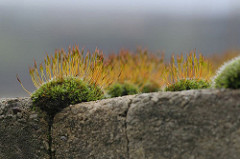
Yesterday afternoon, I used my sexy, new macro lens to take this photograph of a cluster of what, after a few minutes' Googling, I discovered to be wall screw-moss [Tortula muralis]. It's one of the commonest mosses in Britain, thriving in damp, alkaline conditions.
But, as I have recently established, the soil in my garden is decidedly acidic. What's going on there?
Nature really is amazing. In an area surrounded by acid moorland, the wall screw-moss has managed to find itself a small, alkaline niche in the shape of some concrete slabs on top of my garden wall. As both its English and Linnean names imply, this type of moss is often found on walls. The concrete slabs, and the mortar fixing them to the wall, are manufactured using limestone: a particularly alkaline rock. The moss has established itself along a joint in the slabs, where there is presumably more moisture and better anchorage. Having established itself, it is gradually spreading out across the slabs. It might eventually colonise my entire wall.
My Googling led me to an interesting article about Tortula muralis by UK microscopist Derek Christie. Derek confirmed my guess that the quill-like spikes visible in my photograph are spore capsules. The red tip (calyptra) at the end of each capsule is a protective sheaf for the spore-dispersal mechanism, known as the peristome. In dry weather, the calyptra falls away and the peristome untwists to release the spores. Derek suggests it is this untwisting that gives screw-mosses their names (the word tortula means twisted in Latin).
During my very brief research into Tortula muralis, it occurred to me that, if you put your mind to it, you could probably make a lifetime's study of something so apparently simple as this small cluster of moss wedged into a crack in my garden wall—or, indeed, any local population of any species you care to mention. Even the simplest of organisms have a grandeur all of their own. The diversity and complexity of life truly is phenomenal—and we have Charles Darwin to thank for explaining how it got to be that way.